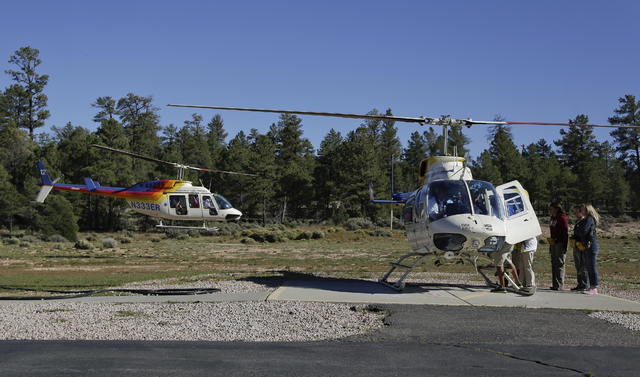Incentives for quieter aircraft take effect over Grand Canyon
FLAGSTAFF, Ariz. — The fees for air tour operators that use technology to quiet the sound of aircraft at Grand Canyon National Park have been reduced.
The new $20 fee per flight took effect Jan. 1 for any of eight operators authorized to take visitors sightseeing over the massive gorge. Operators that don’t have the technology considered to be quiet will continue to pay $25 per flight.
The National Park Service and the Federal Aviation Administration were required to come up with incentives for quiet air technology aircraft at the Grand Canyon as part of a massive transportation bill passed in 2012.
Hikers and tourists on the ground have complained that aircraft noise interferes with the feeling of solitude and appreciation of nature.
“Any kind of a reduction from noise is going to provide a better experience for park visitors,” said park spokeswoman Maureen Oltrogge. “It’s not quiet but it’s quieter than the standard technology.”
The FAA determines whether aircraft is considered quiet using a formula that takes into account noise certification levels and number of seats. About 60 percent of the aircraft conducting tours at the Grand Canyon already meet that standard, Oltrogge said. At full conversion, the reduced fee would save the operators $250,000 a year, she said.
Quiet technology is in use at other national parks, including Volcanoes and Haleakala in Hawaii and the Statue of Liberty in New York, according to the FAA.
The standard doesn’t necessarily mean aircraft will be completely quiet. Operators could, for example, add more seats to existing aircraft or switch out engines to meet the definition of quiet technology.
The benefit to visitors at the Grand Canyon depends on what action the operators take, said Jim McCarthy of the Sierra Club.
“It potentially could be counterproductive,” McCarthy said.
The National Park Service was close to finalizing rules to manage air tours and noise at the Grand Canyon before the federal legislation forced the agency to change its goal for restoring natural quiet to the park. The Park Service wanted to make 67 percent of the canyon quiet for three-fourths of the day or longer.
Some members of Congress pushed a provision in the 2012 federal transportation bill to make half of the park free from commercial air tour noise for at least 75 percent of the day and provide incentives for quiet air technology. Many of the tours originate from Las Vegas.
Oltrogge said the Park Service’s plan that had been in the works for decades since has been halted.
U.S. Sen. John McCain applauded the incentive and said he is looking forward to more meaningful initiatives that would improve access to popular flight corridors for quieter aircraft.
“This is the first step toward meeting the requirement set by Congress to convert all aircraft at the park to quiet technology in a way that protects tourism jobs and allows all visitors to enjoy some of the most breathtaking views of the Grand Canyon,” he said in a statement.























